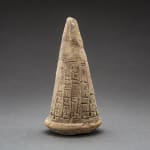Clay Nail with Ten-Line Cuneiform Inscription, 2100 BCE
Terracotta
11.7 x 6.3 cm
4 5/8 x 2 1/2 in
4 5/8 x 2 1/2 in
LSO.703
Sumerian cuneiform is one of the earliest known forms of written expression. First appearing in the 4th millennium BC in what is now Iraq, it was dubbed cuneiform (‘wedge-shaped’) because...
Sumerian cuneiform is one of the earliest known forms of written expression. First appearing in the 4th millennium BC in what is now Iraq, it was dubbed cuneiform (‘wedge-shaped’) because of the distinctive wedge form of the letters, created by pressing a reed stylus into wet clay. Early Sumerian writings were essentially pictograms, which became simplified in the early and mid 3rd millennium BC to a series of strokes, along with a commensurate reduction in the number of discrete signs used (from c.1500 to 600). Cuneiform was used on monuments dedicated to heroic – and usually royal – individuals, but perhaps it’s most important function was that of record keeping. It was also used for votive purposes, as in the present case, to bless or commemorate a building, a deity and the ruler who had commissioned the structure in the first instance. These “nails”, more properly called votive cone inscriptions, are sometimes found in the foundations of important buildings, and in the fabric or repairs to the structure’s original matrix.
The Barakat Gallery has secured the services of Prof Wilfred George Lambert FBA, one of the foremost assiriologists of the last century, who published (among other collections) the Cuneiform Tablets in the Kouyunjik Collection of the British Museum, to examine and process the information on these tablets.
His translation is provided below:
The inscription is from the reign of Gudea, ruler of the small state of Lagash in the far south of Sumer, c.2100 BC. The state had a patron god named Ningirsu, and it was the duty of the ruler to ensure that the temple of this god – called E-ninnu – was kept in good repair. This inscription records the fact for posterity: For Ningursu / mighty warrior of / (the god) Enlil / Gudea / ruler of Lagash / produced everything appropriate / built for him / E-ninnu / his shining Imdugud bird / and restored it. The Imdugud-bird was a mythical creature: a lion with an eagle’s head, and Sumerian scholars often used to use strange metaphors in referring to temples. The nail would have been placed in a hole in the temple wall with the head showing on the surface so that when repairs were necessary, as was often the case since sun-dried bricks were used, the fired nail would be taken out and read, thus perpetuating the memory of the ruler who had it put there”.
The Barakat Gallery has secured the services of Prof Wilfred George Lambert FBA, one of the foremost assiriologists of the last century, who published (among other collections) the Cuneiform Tablets in the Kouyunjik Collection of the British Museum, to examine and process the information on these tablets.
His translation is provided below:
The inscription is from the reign of Gudea, ruler of the small state of Lagash in the far south of Sumer, c.2100 BC. The state had a patron god named Ningirsu, and it was the duty of the ruler to ensure that the temple of this god – called E-ninnu – was kept in good repair. This inscription records the fact for posterity: For Ningursu / mighty warrior of / (the god) Enlil / Gudea / ruler of Lagash / produced everything appropriate / built for him / E-ninnu / his shining Imdugud bird / and restored it. The Imdugud-bird was a mythical creature: a lion with an eagle’s head, and Sumerian scholars often used to use strange metaphors in referring to temples. The nail would have been placed in a hole in the temple wall with the head showing on the surface so that when repairs were necessary, as was often the case since sun-dried bricks were used, the fired nail would be taken out and read, thus perpetuating the memory of the ruler who had it put there”.
1
of
11



